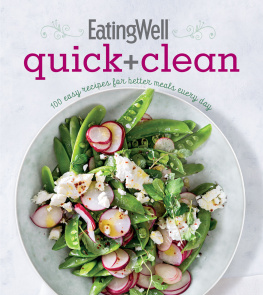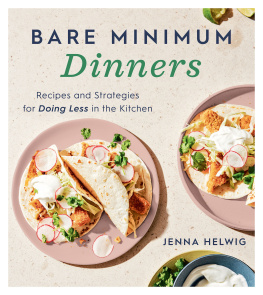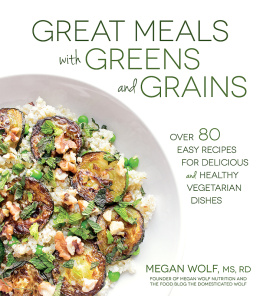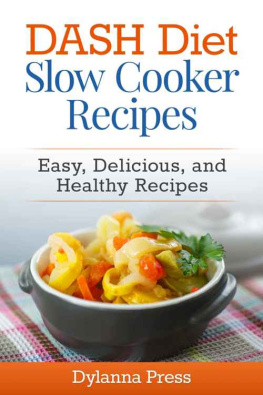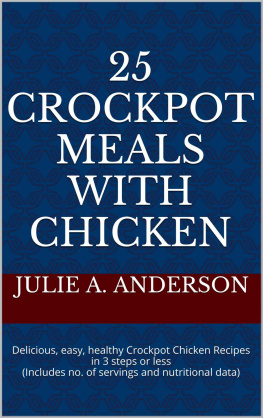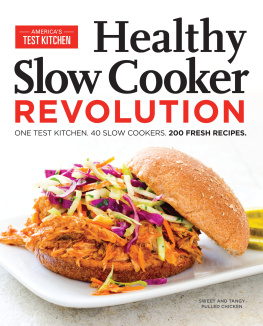

Jamaican Curried Shrimp & Mango Soup (p. 151)
Contents

SIMPLE, EASY
ONE-POT MEALS
T here was no counter in the kitchen of my first apartment in San Francisco. I chopped everything on a wooden cutting board balanced across two burners of the stove, a 1940s Wedgewood (the California stove manufacturer, not the British china). Most weekends in that tiny apartment I would pull out my Dutch oven (one of the few pots I owned) and make a big steaming cauldron of soup. Everything went into the one pot. Id start by dicing onions, carrots and celery on the cutting board on half the stove. Then Id cook the vegetables with a little olive oil on the other half of the stove. When I was done, all I had to clean was my cutting board and that pot. It was so simple, but the soups were satisfying, healthy and delicious.
The one-pot dinner recipes in this book share that simplified approach to cooking. Each recipe is made in just one pot so its easy and streamlined. But were not just talking Dutch ovensa one-pot recipe can be made in a skillet, a slow cooker, a wok or even a roasting pan. Our one rule: no other cooking vessels are used. A salad bowl even counts as a pot in this book. After all, the salad bowl certainly meets the most important criteriait works for making an easy dinner with little cleanup.
Today I have plenty of counter space and all the pots and pans and kitchen doodads I could hope for, but what I lack most often is time. Cooking a meal all in one pot is perfect for anyone who is busy and wants to get a healthy dinner on the table with little fuss. Many of the recipes in this book take less than 30 minutes start to finish. Some take longer, but the cooking is done almost completely unattendedtake the whole chapter of slow-cooker recipes starting on page 128, for example.
All the recipes have been tested by different cooks in the EatingWell Test Kitchen, multiple times, on both gas and electric stoves. The result is recipes that you can trust to work every time you make them in your home kitchen. And you can feel good about sharing these meals with family and friends knowing that each recipe has been reviewed by our team of nutritionists to ensure that calories, saturated fat and sodium are kept in check. The recipes follow the simple approach to healthy cooking that weve been practicing for years: use plenty of fruits and vegetables, go for whole foods over processed, eat lean meats and seafood in moderation, opt for whole grains over refined and choose healthy oils like olive and canola.
Weve worked with many of the best cookbook authors and chefs around, such as Perla Meyers, Deborah Madison and Bruce Aidells, to develop the recipes in this book. Some of my favorites include Red-Cooked Lamb with Sweet Potatoes made in a Dutch oven (page 199), Pad Thai cooked in a wok (page 32) and Easy Paella with Shrimp & Mussels (page 51), which feels like a special event but only takes 40 minutes start to finish, all in one skillet. Throw together a salad while the paella cooks, and youre ready for guests. With the recipes in this book you can get a great, healthy dinner on the table without breaking a sweat and with barely any dishes to do. Before you get started, turn the page for some tips to make your cooking easy and efficient.
Jessie Price
9 ways to be a better cook
Get the right equipment
The seven essential types of pots for one-pot meals include skillets, Dutch ovens, woks, roasting pans, casserole dishes, slow cookers and salad bowls. (Each chapter is devoted to one of these types of pots, so turn to their respective chapters for more information on what to look for.) Besides those pots, a well-stocked kitchen includes a saucepan or two and at least two cutting boards, one for meat and fish and one for everything else. And ideally you should have a third board for fruit, so that it doesnt end up tasting like garlic. We recommend using the biggest cutting boards your space will accommodatethe bigger the board, the more room you have for quickly prepping ingredients. You should also have a set of mixing bowls, dry and wet measuring cups and measuring spoons.
Organize your work space
Create a well-lit, clutter-free prep space in your kitchen that has space for your cutting board, ingredients and a bowl or two. Keep knives close by. And position a garbage can, trash bowl or compost bin within arms reach so you can get carrot peels, onions skins and so forth out of the way. (Of course, your space may be constrained, if you live in a tiny apartment, for instance, so improvise where necessary!)
Shop smart
Half the battle of getting dinner on the table quickly is making sure you dont have to go to the supermarket every other day. The best approach is to make a weekly plan of what youre going to cook, consult your recipes and write a detailed shopping list. You can make your trip to the store as quick as possible if you organize your list by aisle. Try breaking it into these sections: produce, meat & seafood, dry goods, freezer, dairy, refrigerator, bakery & deli.
Keep a well-stocked pantry
When youre making a shopping list, and as you cook and use up ingredients, keep your pantry in mind. If every time you reach the bottom of a bottle of soy sauce you always jot it down on your list, you wont come up empty-handed the next time youre about to throw your ingredients in a wok for a stir-fry. For a complete list of what to stock in a healthy pantry, turn to page 211.
Use the power of herbs and spices
Herbs and spices are essential for making great-tasting food thats healthy too. They let you create bright, aromatic, vibrant-tasting dishes without loading them up with salt, sugar, butter or cream. So keep a well-organized array of dried herbs and spices, preferably close to your work space. Keep in mind that herbs and spices do lose potency the longer they sit on your shelves. After theyve been there a year or two, replace them. And if you have space, plant an herb garden or, if you live in a colder climate, a small planter that you can bring inside in the winter.
Read your recipe
When youre ready to cook, take a moment and read your recipe. Though you may want to dive right in without reading, youll save time in the end, and probably do a better job, if you know what to expect. Of course, were the first to say that you should have fun and experiment in the kitchen; try using different ingredients, add more of something you like or skip something you dont. But for a sure success, follow the recipe and keep in mind the subtle conventions of recipe writing.
The most important convention (thats probably the least obvious) is that the commas in the ingredient list really matter. For example, when we say 1 pound chicken thighs, trimmed we mean that you should buy 1 pound of thighs and then trim the fat off them. If, on the other hand, we call for 1 pound trimmed chicken thighs you would need to either purchase trimmed thighs or buy more than the 1 pound that we want you to cook. Does it really matter? In some cases no, but those small differences will impact the nutrition profile of a dish, and might even affect how something cooks. For instance, if you put too much meat in a stir-fry, you run the risk of overcrowding the wok, causing your meat to stew instead of getting the desired sear. We try to call for ingredients in terms of what you would buy at the market (e.g., 1 small onion rather than 1 cup diced onion). When we call for measures of an ingredient instead of the amount you buy at the market, its typically because the amount of that ingredient has a big impact on the way the dish will turn out.
Next page

